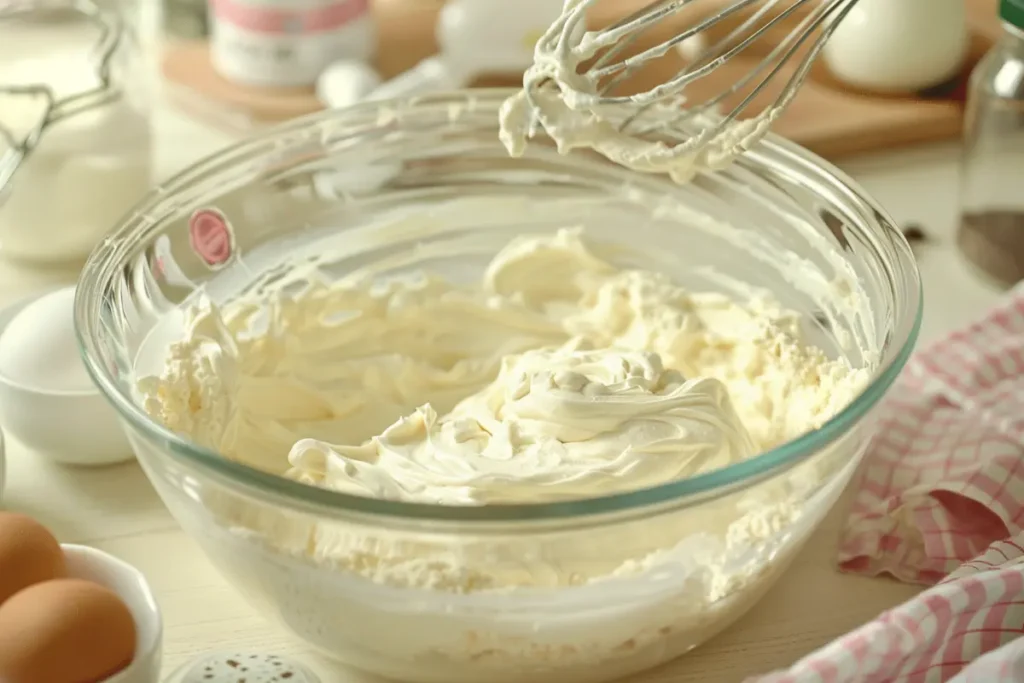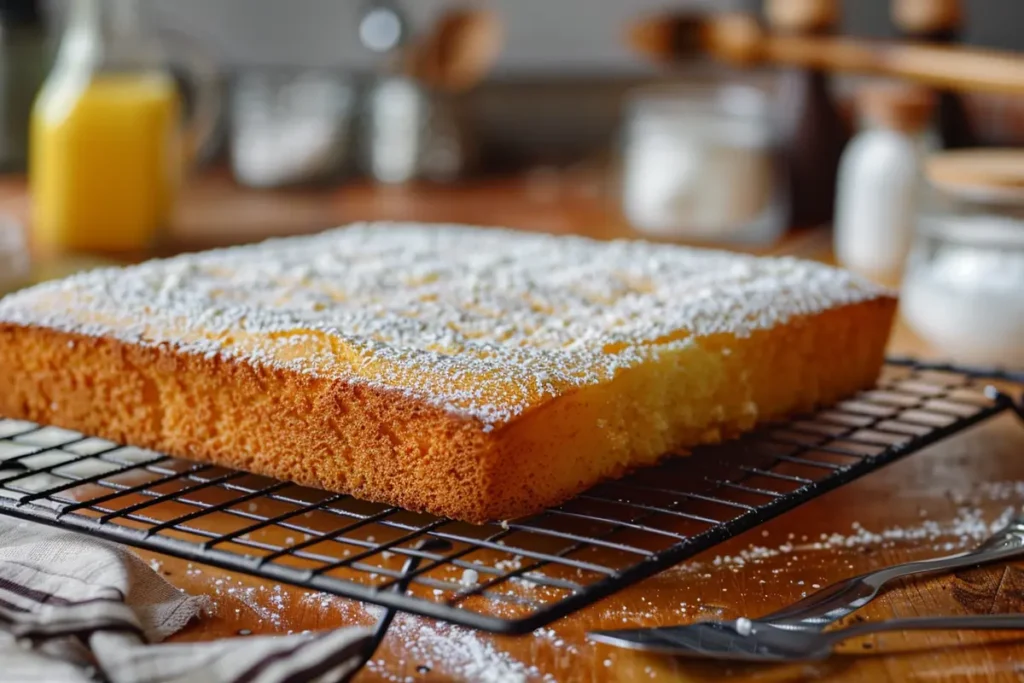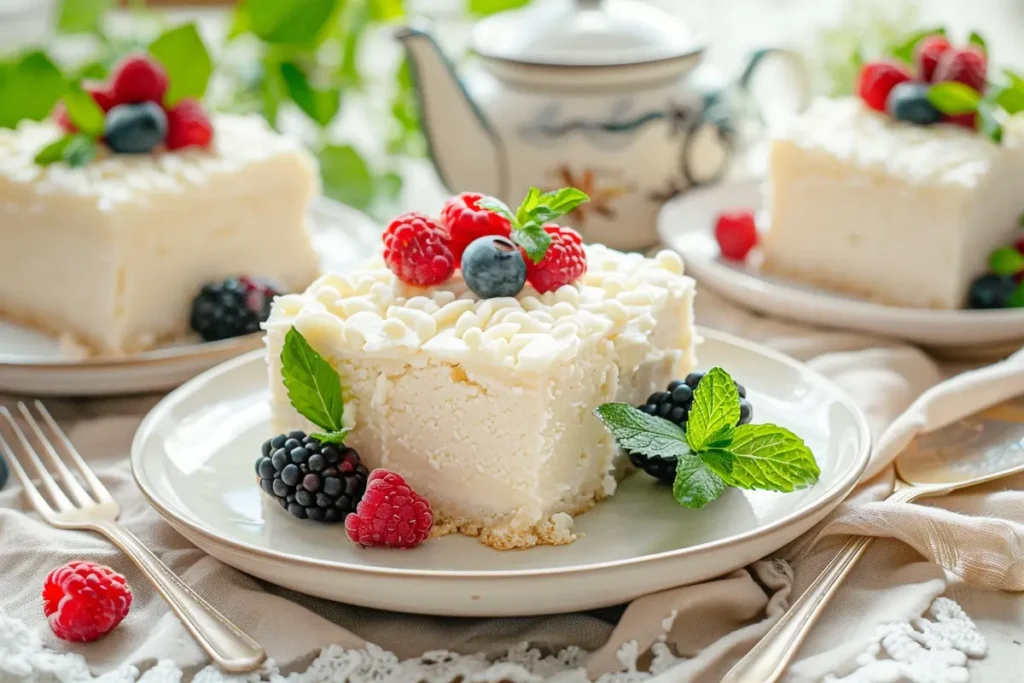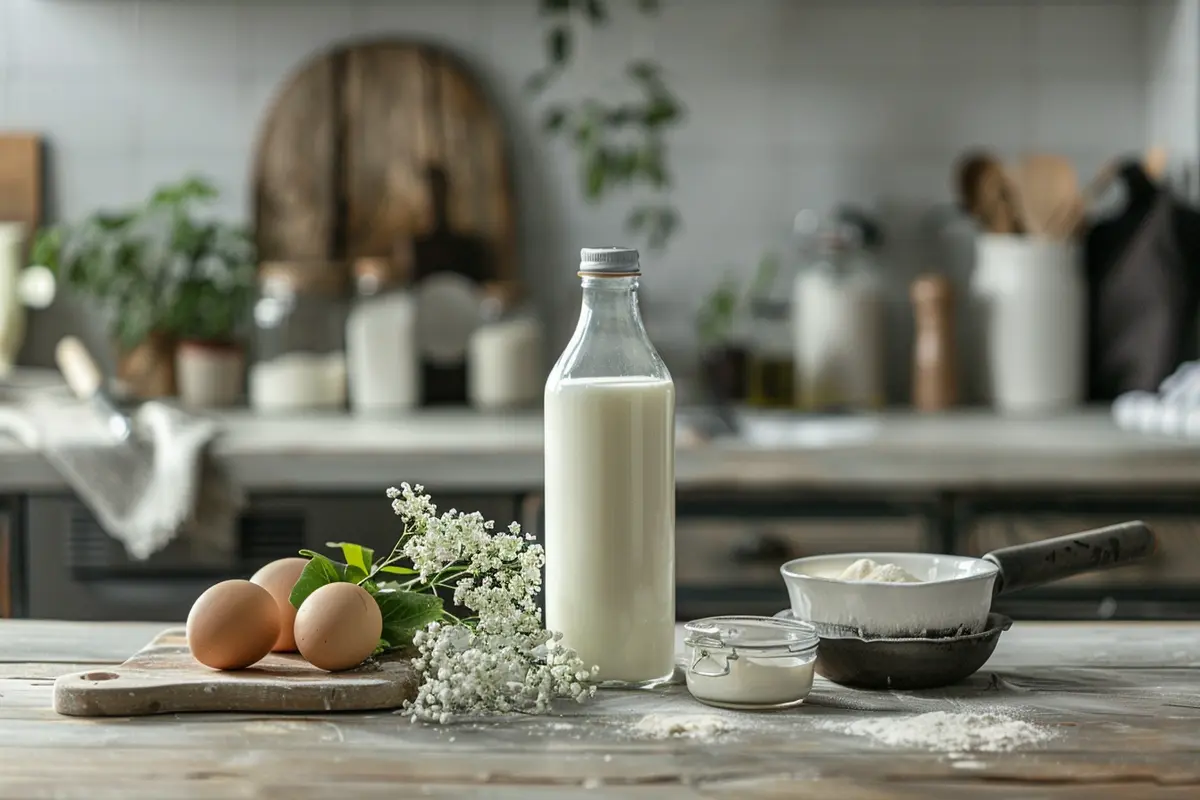If you’re searching for a delicious and moist dessert with a unique twist, look no further than a kefir sheet cake recipe. This delectable treat combines the tangy richness of kefir with the comforting familiarity of a sheet cake. In this article, you’ll discover everything there is to know about baking with kefir, from its health benefits to creative recipe variations. Whether you’re a baking enthusiast or simply looking for a crowd-pleasing dessert, this guide has got you covered.
Discover the Delight of Kefir Sheet Cake
What is Kefir?
Kefir is a fermented dairy product celebrated for its creamy texture and tangy taste. It’s made by fermenting milk with kefir grains, which are clusters of beneficial bacteria and yeast. Often compared to yogurt but lighter and more drinkable, kefir packs a probiotic punch. This makes it a popular choice for those who value gut health and enjoy experimenting with fermented ingredients in their cooking.
One standout feature of kefir is its versatility in recipes. Whether used as a base for smoothies, a substitute for buttermilk, or an ingredient in desserts like the kefir sheet cake, it brings a distinct flavor and health benefits to the table.
The Origin of Kefir Sheet Cake
The kefir sheet cake traces its roots back to regions where kefir has been a dietary staple for centuries, such as Eastern Europe and Central Asia. Over time, this humble cake has evolved into a dessert that combines the simplicity of a sheet cake with the complexity of flavors that only kefir can provide. The fusion of tangy and sweet notes makes it a unique treat for modern bakers.
In these regions, kefir’s probiotic-rich profile was traditionally associated with improved digestion, immunity, and even increased energy. When bakers decided to incorporate it into desserts, the results were nothing short of revolutionary—a light, moist cake that’s perfect for any occasion.
Health Benefits of Using Kefir in Baking
Not only does kefir elevate the taste of baked goods, but it also contributes to a healthier dessert option. Here are some notable benefits of using kefir in baking:
- Probiotic Powerhouse: Kefir is teeming with beneficial bacteria that promote gut health and support digestion. Adding it to a cake means indulging in a treat that doesn’t leave you feeling guilty.
- Rich in Nutrients: This superfood is packed with calcium, B vitamins, and protein, which can be retained even when baked into desserts.
- Natural Tenderizer: The acidity in kefir works wonders for tenderizing baked goods, making cakes extra moist and fluffy without the need for additional fat.
- Low in Lactose: If lactose intolerance has you avoiding dairy-based desserts, kefir could be your ticket back. Its fermentation process breaks down most of the lactose, making it more tolerable for many individuals.
If that wasn’t enough to get you hooked, kefir also adds an intriguing tang that balances out the sweetness of desserts. Baking with kefir isn’t just about flavor—it’s about making smarter, healthier choices while treating yourself.
Kefir isn’t just for cakes—it’s a versatile ingredient in many baked goods. If you’re curious about its role, read our detailed guide on What does kefir do in baking? for more insights.
Ingredients and Preparation
Essential Ingredients for Kefir Sheet Cake
Crafting a kefir sheet cake starts with choosing the right ingredients. Every component plays a crucial role in achieving that perfect balance of flavor and texture. Here’s what you’ll need:
- Kefir: The star ingredient, providing tanginess and moisture. Choose plain, unsweetened kefir for best results.
- All-Purpose Flour: A reliable base for structure, but you can experiment with alternatives like whole wheat or gluten-free flour if needed.
- Sugar: Adds sweetness to balance kefir’s tang. You can opt for white, brown, or even coconut sugar for variations.
- Eggs: They help bind the ingredients while contributing to the cake’s light and fluffy texture.
- Baking Soda or Baking Powder: These leavening agents react with kefir’s acidity to give the cake its rise.
- Butter or Oil: Adds richness and keeps the cake moist. Choose unsalted butter or neutral oils like canola or vegetable oil.
- Vanilla Extract: Enhances the flavor and complements the tangy undertones of kefir.
Each ingredient’s quality and freshness can significantly impact the final result, so always aim for the best you can find.
If you’re out of yogurt for this recipe, don’t worry! You can substitute it with kefir. Learn more about this in our post Can I use kefir instead of yogurt in cake?.
Selecting the Right Type of Kefir
Not all kefir is created equal. When making a kefir sheet cake, stick to plain, full-fat kefir for optimal flavor and texture. Avoid flavored or sweetened kefir, as it can disrupt the balance of the recipe. For those seeking dietary alternatives, coconut or almond milk kefir can be excellent substitutes.
The probiotics in kefir also make it unique. They interact with the other ingredients, particularly the baking soda, creating a chemical reaction that lightens the batter and adds to the cake’s airy quality.
Importance of Fresh Ingredients
The quality of your ingredients is paramount when preparing a kefir sheet cake. Fresh eggs yield better rise, and fresh flour minimizes any risk of off-flavors. Moreover, using high-quality butter or oil ensures a luscious texture.
Pro tip: Always check the expiration date on your kefir. Though it’s a fermented product, fresh kefir has a more vibrant flavor and active probiotics.
Step-by-Step Preparation Guide
Ready to start baking? Here’s a detailed guide to help you create the most delectable kefir sheet cake.
Mixing the Batter

- Combine Dry Ingredients: In a large bowl, whisk together the flour, sugar, and baking soda. This ensures an even distribution and avoids clumping.
- Prepare the Wet Mixture: In a separate bowl, beat the eggs, add kefir, and mix in the melted butter or oil and vanilla extract.
- Bring It All Together: Gradually add the wet ingredients to the dry ones, folding gently to avoid overmixing. The batter should be smooth but slightly thick.
Baking Instructions
- Preheat the Oven: Set it to 350°F (175°C) and grease a large rectangular baking pan or line it with parchment paper.
- Pour the Batter: Evenly spread the batter in the prepared pan to ensure consistent baking.
- Bake: Place the pan in the oven and bake for 25–30 minutes. Keep an eye on it—once a toothpick inserted in the center comes out clean, it’s done.
Cooling and Serving Tips

After removing the cake from the oven, let it cool in the pan for 10–15 minutes. Then transfer it to a wire rack to cool completely. This step is crucial as cutting it too soon can cause it to crumble.
Serve plain, or dress it up with frosting or glaze. Either way, your guests will be clamoring for seconds!
Variations and Enhancements
Popular Variations of Kefir Sheet Cake
One of the joys of a kefir sheet cake recipe is its flexibility. By tweaking a few ingredients, you can transform the cake to suit any taste preference or occasion.
- Fruit-Infused Cake: Add diced apples, pears, or berries to the batter for bursts of natural sweetness. Blueberries are a fan favorite as they pair beautifully with kefir’s tang.
- Nutty Delights: Fold in chopped walnuts, pecans, or almonds to introduce a satisfying crunch. Toasting the nuts beforehand amplifies their flavor.
- Chocolate Twist: For chocolate lovers, mix cocoa powder into the dry ingredients or sprinkle chocolate chips into the batter.
Experimenting with these variations allows you to enjoy a fresh take on this classic dessert each time you bake.
Adding Fruits and Nuts
Fruits and nuts do more than enhance flavor—they also add a visual appeal and nutritional value to the cake. If using fresh fruits, ensure they’re ripe yet firm to avoid excessive moisture. For nuts, coarsely chop them to maintain texture without overwhelming the cake.
Pro tip: Toss fruit pieces or nuts in a bit of flour before folding them into the batter. This prevents them from sinking to the bottom during baking.
Flavoring with Spices
Spices can elevate the flavor profile of a kefir sheet cake. A pinch of cinnamon or nutmeg adds warmth, while a hint of cardamom introduces a subtle exotic aroma. Ginger powder or a splash of orange zest works wonders for a festive twist.
The key is balance—let the spices complement the tanginess of the kefir without overshadowing it.
Frosting and Topping Ideas
A great frosting or topping takes a kefir sheet cake from delightful to downright irresistible. Here are some crowd-pleasing options:
Chocolate Glaze
- Melt ½ cup of dark chocolate with 2 tablespoons of butter over low heat.
- Stir in a splash of milk until smooth and glossy.
- Drizzle or spread over the cooled cake for a decadent finish.
Cream Cheese Frosting
- Beat together 8 ounces of cream cheese, ¼ cup of butter, 2 cups of powdered sugar, and a teaspoon of vanilla extract.
- Spread evenly over the cake for a rich, tangy topping that complements the kefir flavor perfectly.
These enhancements not only add flavor but also create an elegant presentation, making the cake a show-stopper for any occasion.
Serving Suggestions and Storage
Ideal Occasions for Serving Kefir Sheet Cake
The kefir sheet cake is as versatile as it is delicious, making it perfect for a variety of events:
- Family Gatherings: Its soft texture and balanced sweetness appeal to all age groups.
- Potlucks and Parties: The sheet cake’s size ensures plenty of servings for a crowd.
- Weeknight Desserts: Quick to bake and easy to serve, it’s a convenient choice for any day.
Whether you dress it up with toppings or serve it plain, this cake shines as a centerpiece for any celebration.
Pairing Kefir Sheet Cake with Beverages

To complete the experience, pair your cake with the right beverage. Its tangy and sweet flavors go well with:
- Hot Drinks: Coffee, tea, or a frothy cup of hot chocolate are classic pairings.
- Milk Alternatives: Almond, oat, or coconut milk complement the cake’s flavor and keep it light.
A thoughtful pairing can elevate the cake into a memorable dessert moment.
Proper Storage Techniques
Storing a kefir sheet cake properly ensures it remains fresh and flavorful for days. Here’s how:
Refrigeration and Freezing
- Refrigeration: Store the cake in an airtight container and refrigerate for up to 5 days. This helps maintain moisture and prevents spoilage.
- Freezing: Wrap individual slices in plastic wrap and place them in a freezer-safe bag. They’ll keep well for up to 3 months.
When you’re ready to enjoy a slice, simply thaw it at room temperature or pop it in the microwave for a few seconds.
Reheating Methods
While the cake is delicious at room temperature, reheating it can revive its freshly baked texture. Use these methods:
- Microwave: Warm a slice for 10–15 seconds to soften it without drying it out.
- Oven: Place the cake on a baking sheet, cover with foil, and warm it in a 300°F oven for about 5 minutes.
These tips ensure that your kefir sheet cake tastes just as delightful as when it first came out of the oven.
Frequently Asked Questions
What does kefir do in baking?
Kefir is a game-changer in the baking world, thanks to its unique properties. As a fermented dairy product, kefir contains natural acids and probiotics that react with leavening agents like baking soda, creating a light and fluffy texture. It also imparts a subtle tanginess to the baked goods, which adds depth to flavors. Additionally, kefir serves as a natural tenderizer, ensuring your cakes stay moist and soft without needing excess fat or sugar.
Kefir also boosts the nutritional profile of your desserts. Its probiotic-rich composition contributes to gut health, making it a wholesome addition to your recipes.
Can I use kefir instead of yogurt in cake?
Yes, kefir is an excellent substitute for yogurt in cake recipes. Both have similar tangy flavors and creamy consistencies, which makes the swap seamless. However, because kefir is thinner than yogurt, you may need to adjust the recipe slightly.
Pro tip: If your batter feels too runny after substituting kefir for yogurt, add a little extra flour to balance the consistency. This ensures the cake bakes evenly without compromising its texture.
Using kefir instead of yogurt can also enhance the nutritional value of your cake, thanks to the additional probiotics and enzymes in kefir.
Can I use kefir instead of buttermilk in cake?
Absolutely! Kefir and buttermilk share similar acidity levels, making kefir a perfect replacement in most recipes. In fact, some bakers prefer kefir because of its probiotic content and slightly more complex flavor profile.
When using kefir as a buttermilk substitute, the measurements remain the same (1:1 ratio). The acidity in kefir will still activate the baking soda or powder, ensuring your cake rises beautifully. Plus, the cake gains the added benefit of kefir’s creamy texture, which contributes to a moist and tender crumb.
What are sheet cakes baked in?
Sheet cakes are traditionally baked in large, shallow rectangular pans. These pans are designed to allow the batter to spread evenly, ensuring a consistent thickness and even baking. Here are some common options:
- Half-Sheet Pans: Ideal for medium-sized gatherings, typically measuring 18 x 13 inches.
- Quarter-Sheet Pans: Perfect for smaller portions, measuring around 9 x 13 inches.
- Full-Sheet Pans: Used for large events, measuring approximately 26 x 18 inches.
The shallow depth of these pans allows the heat to penetrate quickly, resulting in a perfectly baked sheet cake with a soft interior and lightly golden crust. Line the pan with parchment paper or grease it thoroughly to ensure easy removal and clean edges.
These frequently asked questions highlight kefir’s versatility and offer helpful insights into perfecting your kefir sheet cake recipe. Ready to take your baking skills to the next level? Keep exploring creative ways to use this probiotic-rich ingredient in your kitchen!
Conclusion
A kefir sheet cake isn’t just another dessert; it’s a celebration of flavor, texture, and creativity. By incorporating kefir into baking, you’re not only adding a tangy twist to a classic treat but also reaping the nutritional benefits of probiotics and essential nutrients. Whether served at a family gathering, shared at a potluck, or enjoyed as a quiet indulgence, this cake never fails to impress.
The magic of a kefir sheet cake recipe lies in its versatility. It can be adapted with fruits, nuts, or spices to suit any occasion, and its moist, tender crumb ensures it remains a favorite across generations. What’s more, its simplicity in preparation makes it accessible even for novice bakers.
Baking with kefir is about more than just achieving great taste. It’s an opportunity to blend health and indulgence, proving that a dessert can be both delicious and nourishing. From the batter’s preparation to the final bite, the journey of creating a kefir sheet cake is as satisfying as the cake itself.

